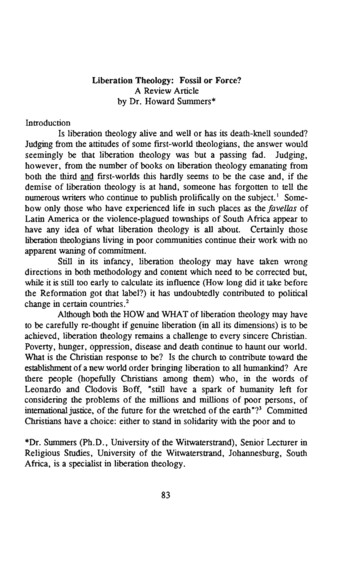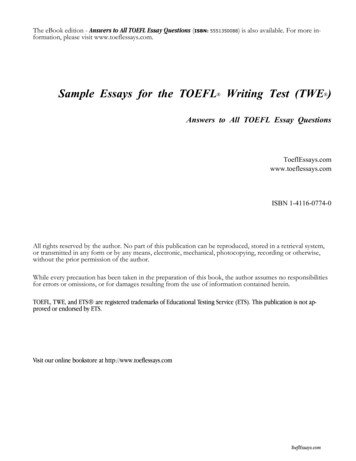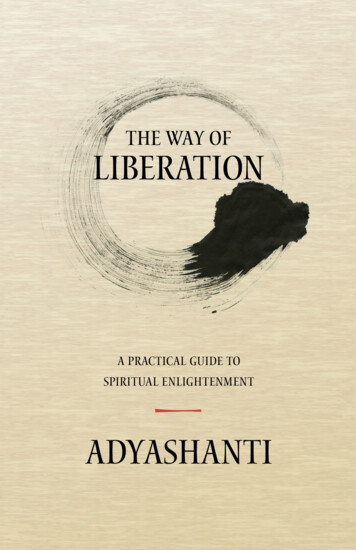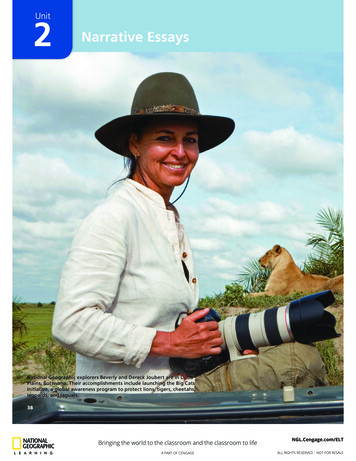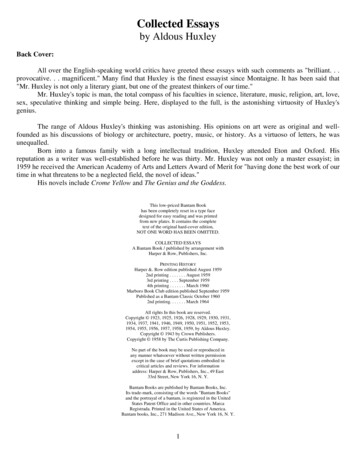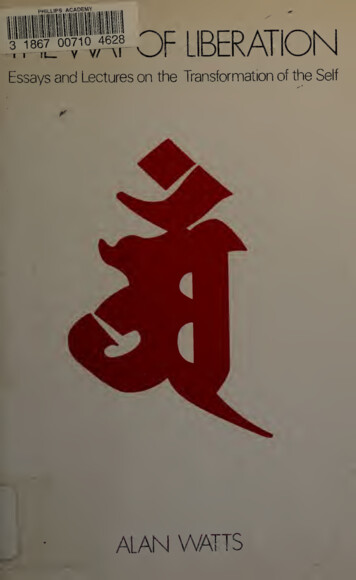
Transcription
OF LIBERATIONEssays and Lectures on the Transformation of the SeifALAN WATTS
9.95f /I / ords can express no more than a tiny frag\J V ment of human knowledge, for what we cansay and think is always immeasurably less than whatwe experience.Alan Watts wrote this in 19jf, in preparationfor publishing the now classic Way of Zen.Between that time and his death he both learnedand unlearned a great deal more about Zen andlife.For this volume, a series of essays and lectureshave been assembled by the author's son. FromWatts’s first essay oh Zen Buddhism to his'finalseminar—given only weeks before his death—the chapters contained herein offer the readera unique insight into the meaning of life.Although approached from many angles, thebasic theme is that liberation of any kind canonly be achieved through the art of finding andfollowing what Watts called “the watercourseway,” known to the ancient Chinese as the Tao.“Play and Survival,” his last seminar, showshow his thought evolved and stresses the im portance of play in our lives.This concept of playful interaction with every thing we come upon in our lives culminates in“The Relevance of Oriental Philosophy," inwhich Watts examines the significance ofEastern teachings in terms readily understandableto Westerners.Western man’s attempts at self-improvementinevitably give rise to conflicts, and the re conciliation of these is addressed in “Suspensionof Judgment," which suggests the Taoist conceptof mi-ivei, or of letting go, as a solution.11" Watts introduces that Chie necessity of in the
THE WAY OF LIBERATION
If you thinkby sittingyou can become a buddha . . .
THE WAY OFU DERATIONEssays and Lectureson theTransformationof the SefALAN WATTSedited and transcribed byMark Watts and Rebecca ShropshireWEATHERHILLNew York Tokyo
Reproduced on the title page isa Zen painting by Sengai (1750-1837)from the collection of the Idemitsu Art Gallery.First edition, 1983Fourth printing, 1987Published by John Weatherhill, Inc.,of New York and Tokyo,with editorial offices at7-6-13 Roppongi, Minato-ku, Tokyo 106, Japan.Protected by copyright under terms ofthe International Copyright Union;all rights reserved.Printed in Japan.Library of Congress Cataloging in Publication Data:.Watts, Alan, 1915—73.Essays and lectures on the transformation of the self.Contents: The way of liberation in Zen Buddhism—Play and survival— The relevance of Oriental philosophy—[etc.]1. Philosophy, Oriental—Addresses, essays, lectures.2. Salvation—Addresses, essays, lectures.3. Meditation—Addresses, essays, lectures.I.Watts, Mark.B945.W321II. Shropshire, Rebecca.19S3128III. Title.82-21917ISBN 0-8348-0181-7'
TOOUR FATHERSANDOUR MOTHERS
, H ,' t,.' i.
CONTENTSPreface, by Mark WattsixForeword, by George Inglesxi1The Way of Liberation in Zen Buddhism2Play and Survival:Contradiction?3Are They in Necessary233The Relevance of Oriental Philosophy394Suspensionofof Judgment:Transformation5TheTangles55Chuang-tzu: Wisdom of the RidiculousThe Practice of MeditationNotes739197contentsvii
.,
PREFACETHE FOLLOWING chapters hold for the reader arich selection of literary works and transcribed lec tures by the late Alan Watts. They comprise a representativeview of his career, from his first essay on Zen Buddhismto his final seminar given only weeks before he died in 1973.Herein, one will find an overview of the formative in fluences which shaped Watts’s philosophy,and whichin turn offer the reader a unique insight into the process ofrealization that, through his works, has given the Westernworld an unprecedented perspective of Eastern thought.The opening essay, “The Way of Liberation in ZenBuddhism,” was written in 1955, prior to Watts’s moreextensive work on the subject, The Way of Zen. AlthoughThe Way of Zen contains many of the same concepts aspresented in this essay, the essay offers a refreshinglyconcise and inspired approach to Zen by Watts.In juxtaposition to the first essay, the subsequent tran scription of Watts’s last seminar, “Play and Survival,”PREFACEIX
shows how his thought evolved through all that followed.The flowering of his inquiry into Eastern philosophy isperceived as culminating in a playful synthesis of philosoph ical insight. This interaction is crystallized in the nextselection,“The Relevance of Oriental Philosophy,” inwhich Watts discusses the fundamental questions posed byEastern religions to Westerners of a Christian background.The next chapter is a lecture transcription, “Suspensionof Judgment,” in which Watts addresses the inevitablequestions and conflicts that arise from the Western man’sattempts at self-improvement, and reconciles these withthe Eastern concept of wu wei, or of letting go, and ofnon-interference with the way the world is.In the next chapter, “Chuang-tzu: Wisdom of the Ridi culous,” Watts introduces the Chinese philosopher whohe feels is most unique in the whole history of philosophy.He presents Chuang-tzu’s humorous approach to the pur poselessness of existence, and, in doing so, points out thatall activity directed toward future goals is meaningless with out the continuous, fully embraced realization of the pre sent moment.How to “live in the present” is delightfully discussed in“The Practice of Meditation,” presented here in Watts’sown calligraphy and illustrated by one of his drawings ofBodhidharma.In the developing of this work, I am extremely gratefulto Rebecca Shropshire for transcribing and editing thespoken lectures,and toGeorge Ingles for his literaryassistance and scholarly advice.Mark WattsMill Valley, CaliforniaSeptember 1982XPREFACE
FOREWORDTO MANY people, the late Alan Watts remains theguru par excellence even though he made no claims tosuch exalted titles, and rather fashioned himself as a “phil us in his own whimsical, yet extremely talented way.His sense of hilarity, his humor and ability to play, his easylaughter, and his claim not to be serious but to always besincere aretrulycharacteristicof a highlydevelopeddegree of consciousness. One is reminded here of the divinein Vedantic philosophy who is always at play, Brahman,totally involved in his lila, playing the entire universe; orthe Hindu myth of Shiva, who dances the cosmic illusionin his aspect of Nataraja. Watts had a lifelong interest inthese themes, and he frequently spoke about them with hisusual excellence of interpretation in numerous lectures andprolific writings.Like all philosophers and mystics who represent the“Perennial Philosophy,”Watts’s work grew out of aFOREWORDXI
central experience usually referred to as samadhi, satori,cosmic consciousness, or spiritual union with God. In truth,it is this experience that allows a distinction between anenlightened mind, with its clear depth of vision, and themere abstractions of a groping intellect.Philosophia Perennis is a phrase which, as far as we know,was first used by the seventeenth-century German philos opher, Leibnitz. At present, it may be used to explain thecollective wisdom that grows out of the samadhi experienceand that has been universally recorded in the world’s greatliterature,sacredwritings,myths,and symbols,fromprerecorded time to the present day. Although there havebeen many attempts to describe this experience of theforemost and highest state of consciousness, it is usuallyconsidered futile to attempt any description since thisgreat experience is ineffable.The Chinese sage Lao-tzu declared in his opening state ment to the Tao Te Ching, “The Tao that can be explainedis not the true Tao,” and yet he went on to compose awhole book about it. So too, Shakyamuni Buddha is re ported to have said, “What I have to teach cannot betaught,” and yet he went on to teach for over forty-fiveyears. In the gospel of St. John we read that when the cyni cal Pontius Pilate asked Jesus, “What is truth?” there wasno reply. Alan Watts was fond of using the Greek wordmuein, which he liked to translate as meaning “mum’sthe word”—it cannot be spoken. But as is well known,Watts could never be accused of silence, since he has leftus over twenty books, countless articles, and an innumera ble amount of lectures that fortunately have been recordedon tape. This outpouring of words is indicative of the in tellectual’s need to verbalize and the poet’s need to embel lish in order to extract some comprehension from theexperience. Thus we have the “Perennial Philosophy.”To the mystic this experience is the criterion of thesoteriological,XUortheFOREWORDconfirmationof theredemptive
aspect within the entire spectrum of religious experience.Although it can never be imagined, preconceived, or com prehended by the intellect, it seems to occur most fre quently through a total and unreserved surrender to thedivine. Most often it follows a rock bottom, extremelypainful, and intensely desperate state of mind, a strangecoincidence of the opposites when abyssmal darkness turnsinto the most glorious light. Just as the lotus flower growsout of the mud, there is an emergence from a chaotic stateto the heights of ecstatic bliss. This brings to mind theoccurrence in the life of Ramakrishna as he was about tocommit suicide immediately prior to his samadhi in theform of a “revelation of the Divine Mother.”As Alan Watts made vividly clear in one of his finest es says, “This Is It,” the individual will interpret this sublimeexperience within the context of the religious and philosoph ical milieu of his particular culture,and will expressit as a confrontation with or an interior realization of thedivine:The terms in which a man interprets this experienceare naturally drawn from the religious and philosophi cal ideas of his culture and their differences often con ceal its basic identity. As water seeks the course ofleast resistance, so the emotions clothe themselves inthe symbols that lie most readily at hand, and the as sociation is so swift and automatic that the symbol mayappear to be the very heart of the experience. Clarity—the disappearance of problems—suggests light, andin momentsof suchacuteclaritytheremay bea sensation of light penetrating everything. . . . Onefeels himself taken up and united with a life infinitelyother than his own. But as the beating of the heartmay be regarded as something that happens to you orsomething that you do, depending on the point ofview, so another will feel that he has experienced, notFOREWORDxiH
a transcendent God, but his own inmost natuie. Onewill get the sense that his ego or self has expanded tobecome the entire universe, whereas another will feelthat he has lost himself altogether and that what hecalled his ego was never anything but an abstraction.One will describe himself as infinitely enriched, whileanother will speak of being brought to such absolutepoverty that he owns not even his mind and body,and has not a care in the world.1In the afterglow of this experience, one may realize thecosmic purpose and spiritual siginificance of all life. Totalexistence becomes sacred. One is overwhelmed with loveand humility.All things are affirmed just as they are,and it is felt that everything has always been just right.Although the rapture diminishes in time, the mind retainsa sense of certainty and an element that gradually grows intoan integral state of being which is eventually expressed inthe recipient’s everyday life.Through interior cultivation or by the removal of variousobstructions and simply letting “It” flow, some attain thefinal flowering of the spiritual quest in altruism or lovingservice.One of the greatest examples we have in theworld at the present time is in the life and work of MotherTeresa in Calcutta. However, to these few it does not seemthat they attain anything, but rather receive “It” as a giftby grace alone.But let us give the last word on this to the great historianof religions, Mircea Eliade, quoting from his book, The Twoand the One, in which he sums up the chapter “Experiencesof the Mystic Light” :For all conceptualization is irremediably linked withlanguage, and consequently with culture and history.One can say that the meaning of the supernatural lightis directly conveyed to the soul of the man who ex periences it—and yet this meaning can only comeXIVFOREWORD
fully to his consciousness clothed in a preexistentideology. Here lies the paradox: the meaning of thelight is, on the one hand, ultimately a personal dis covery and, on the other, each man discovers what hewas spiritually and culturally prepared to discover. Yetthere remains this fact which seems to us fundamental:whatever his previous ideological conditioning, a meet ing with the Light produces a break in the subject’sexistence, revealing to him—-or making clearer thanbefore—the world of the Spirit, of holiness and offreedom, in brief, existence as a divine creation, orthe world sanctified by the presence of God.2From a very early age in his life, Watts was fascinated andintensely interested in “all things of the Orient.” It isneedless to say here that his gifted interpretations of Eas tern religion and philosophy are included among the verybest. And yet, for some odd reason, there have been bothcritics and admirers who, having made superficial evalua tions of his work, refer to him as a “popularizer” of ZenBuddhism. To the discerning mind, however, it will beapparent that his major contribution is in his interpretationand celebration of the mystical experience. As he himselfwrote when he was about halfway through his career:I saw everything, just as it is now, is IT—is thewhole point of there being life and a universe. I sawthat when the Upanishads said, “That thou art!” or“All this world is Brahman,” they meant just exactlywhat they said.Each thing,each event, each ex perience in its inescapable nowness and in all its ownparticular individuality was precisely what it shouldbe, and so much so that it acquired a divine authorityand originality. It struck me with the fullest clarity thatnone of this depended on my seeing it to be so; thatwas the way things were, whether I understood itor not, and if I did not understand, that was IT too.FOREWORDXV
Furthermore,I feltthatI now understoodwhatChristianity might mean by the love of ionofthings, they were nonetheless loved by God just asthey are, and that this loving of them was at the sametime the godding of them. This time the vivid sensationof lightness and clarity lasted a full week.These experiences, reinforced by others that havefollowed, have been the enlivening force of all mywork in writing and in philosophy since that time.3The genius of Alan Watts was in his originality andmethod—in his ability to remove all obstructions from themind flow and to simply allow a frolic of words to gushforth in a seemingly magical arrangement of gaiety, wit,and humor with profound meaning and instruction; hisgifted use of the English language; his extraordinary me mory; and his wide range of interests and learning, whichtook in not only the history of religious and philosophicalthought, but also included the work of such eminentscientists as L. L. Whyte, Gregory Bateson, David Bohm,Joseph Needham, and others, including Korzybski, Sapir,Whorf, and Wittgenstein.Through his representation of the “Perennial Philoso phy,” and his synthesis of the views of Vedanta, MahayanaBuddhism, and Taoism, Watts’s work has become respectedamong the less dogmatic and more liberal-minded membersof the scientific community. This in turn has opened upmore dialogue and communication between Eastern reli gionists and modern empiricists, which in the course oftime should influence even the most elementary educationalsystems.In the following lectures, which have been selected andedited by Alan’s son, Mark Watts, we have some exemplarytalks that Dr. Watts gave between the years 1966 andXVIFOREWORD
1973. Also included is one earlier work that was writtenin 1955.One may discover that throughout most of his lifeWatts possessed an attitude of grand affirmation and joyousparticipation in all existence. He enjoyed himself underalmost alay circumstances, had good fortune, and seemedto ride the crest of a wave throughout his entire life.By familiarizing ourselves with his many writings andlectures, we may find that this same attitude can be awak ened in us, and we can join Watts in singing along withNammalvar:He is not: He is.Thus it is impossible to speak of Him,Who has pierced the earth and the skyAnd become the inner ruler in all.He is unaffected by defects.He is the abode of bliss.Such a person have I attained.4George InglesBerkeley, CaliforniaMarch 1982FOREWORDxvii
THE WAY OF LIBERATION
CHAPTER ONETHE WAY OF LIBERATIONIN ZEN BUDDHISMWORDS CAN express no more than a tiny fragmentof human knowledge, for what we can say and thinkis always immeasurably less than what we experience. Thisis not only because there are no limits to the exhaustivedescription of an event, as there are no limits to the possibledivisions of an inch; it is also because there are experienceswhich defy the very structure of our language, as water can not be carried in a sieve. But the intellectual, the man whohas a great skill with words, is always in danger of restrict ing what can be known to what can be described. He istherefore apt to be puzzled and suspicious when anyonetries to use ordinary language to convey an experiencewhich shatters its logic, an experience which words canexpress only at the cost of losing their meaning. He issuspicious of fuzzy and ill-conceived thinking, and concludesthat there is no experience that can correspond to suchapparently nonsensical forms of words.This is particularly true of an idea which crops up reLIBERATION IN ZEN3
peatedly in the history of philosophy and religion—theidea that the seeming multiplicity of facts, things, andevents is in reality One, or, more correctly, beyond duality.This idea is usually intended to convey more than a specu lative theory; it is intended to convey the actual experienceof unity, which may also be described as the sense thateverything that happens or can happen is right and naturalin so positive a way that it can even be called divine. To putit in the words of the Shinjinmei:One is all;All is one.If only it can be thus,Why trouble about being imperfect?To the logician such an utterance is meaningless, and to themoralist it is plainly subversive.Even the psychologistmav wonder whether there can be a state of mind or feelingthat such words can faithfully represent.For he mayinsist that sensations or feelings are recognizable only bytheir mutual differences, as we know white by contrastwith black, and that therefore a sensation of non-difference,of absolute oneness, could never be realized. At most itwould be like putting on rose-tinted spectacles. One wouldat first be aware of rosy clouds by contrast with the me mory of white clouds, but in time the contrast would fade,and the all-pervasive hue would vanish from consciousness.Yet the literature* of Zen Buddhism does not suggest thatthe experience of unity or non-duality is recognized onlytemporarily, by contrast with the former experience ofmultiplicity. It suggests that it is an abiding experiencethat by no means fades with familiarity. Our best way ofunderstanding it will be to follow, as best we can, the innerprocess through which the experience is realized. Thiswill mean, in the first place, treating it from the psycho logical point of view, to find out whether the words ex-4THE WAY OF LIBERATION
press any psychological reality, let alone any logical senseor moral propriety.It may be assumed that the starting point is the ordinaryman’s feeling of conflict between himself and his environ ment, between his desires and the hard facts of nature,betweerf his own will and the jarring wills of other people.The ordinary man’s desire to replace this sense of conflictby a sense of harmony has its parallel in the age-old concernof philosophers and scientists to understand nature in termsof a unity—in the human mind’s perennial discontent withdualism. We shall see that this is in many ways a ratherunsatisfactory starting point. The problem of telling any one how to proceed from this point to the experience ofunity reminds one of the yokel who was asked the way toan obscure village. He scratched his head for a while andthen answered, “Well, sir, I know where it is, but if Iwere you I wouldn’t start from here.” But unfortunatelythis is just where we are.Let us, then, consider some of the ways in which the Zenmasters have handled this problem. There are four ways inparticular that seem to deserve special attention, and thesemay be listed briefly as follows:1. To answer that all things are in reality One.2. To answer that all things are in reality Nothing, Void.3. To answer that all things are perfectly all right andnatural just as they are.4. To say that the answer is the question, or the ques tioner.The question itself may assume many different forms, butessentially it is the problem of liberation from conflict,from dualism, from what Buddhism calls the samsara orvicious circle of birth-and-death.1. As an example of the first type of answer, the assertionthat all things are in reality One, consider the words of Eka:LIBERATION IN ZEN5
The profound truth is the principle of ultimateidentity.Under delusion the mani gem may be calleda broken tile,But when you enter truly into self-awakeningit is a real pearl.Ignorance and wisdom are alike without differ ence.For you should know that the ten thousandthings are all Suchness (tathata).It is out of pity for those disciples who holda dualistic viewThat I put words in writing and send thisletter.Regarding this body and the Buddha as neitherdiffering nor separate,Why, then, should we seek for something thatdoes not need to be added to us?1The implication of this answer is that liberation from theconflict of dualism does not require any effort to changeanything. One has only to realize that every experienceis identical with the One, the Buddha-nature, or the Tao,and then the problem will simply vanish. Similarly, whenJoshu asked Nansen, “What is the Tao?” Nansen replied,“Your ordinary mind is the Tao.” “How,” asked Joshu,“can one return into accord with it?” Nansen answered,“By intending to accord you immediately deviate.”2The psychological response to answers of this kind willbe an attempt to feel that every experience, every thought,sensation, or feeling is the Tao—that somehow the goodis the same as the bad, the pleasant the same as the pain ful. This may take the form of trying to attach the symbolthought “this is the Tao” to each experience as it arises,though obviously it will be hard to realize much content,much meaning, in a symbol which applies equally to every6THE WAY OF LIBERATION
possible experience. Yet as the frustration of not realizingany content arises, it is asserted that this, too, is theTao—so that any grasp of what the nature of this One thatis All may be becomes more and more elusive.2. Thus another, and perhaps better, way of answeringthe original question is to assert that all things are inreality No-thing or Void (shunyata), following the doc trine of the Prajnaparamita-hridaya-sutra. “Form is preciselythe void; the voidis preciselyform.”Thisanswerprovokes no attempt to find content or meaning in the termused to represent the One reality. In Buddhism the wordshunya or Void implies inconceivability rather than merenothingness. The psychological response to the assertionthat all is One might be described as an attempt to say“Yes” to every experience as it arises, as an attempt toachieve a total acceptance or affirmation of life in all itsaspects.Contrariwise,the psychological response sug gested by the assertion that all is Void would be an at tempt to say “No” to each experience.This is found also in the Vedanta, where the formula neti,neti,“not this, not this,” is used to support the under standing that no experience is the One reality. In Zen, theword mu3 —no, not, or nothing—is used in a similar way,and is often employed as a koan4 or initiatory problem inmeditation for beginners in such a way that at all times andunder all circumstances one persists in saying the word“No.” Hence the reply of Joshu to the question, “How willit be when I come to you without a single thing?” “Throwit down!”53. Then there are the answers which seem to imply thatnothing has to be done at all, neither saying “Yes” toeverything nor “No” to everything. The point here israther to leave one’s experience and one’s own mind aloneand allow them to be just as they are. Consider the follow ing from Rinzai:LIBERATION IN ZEN7
“One can only resolve past karma as the circumstancesarise. When it’s time to dress, put your clothes on. Whenyou have to walk, then walk. When you have to sit, thensit. Don’t have a single thought in your mind about seekingfor Buddhahood. How can this be? The ancients say, ‘Ifyou desire deliberately to seek the Buddha, your Buddhais just Samsara.’ . . . Followers of the Tao, there is noplace in Buddhism for using effort. Just be ordinary,without anything special. Relieve your bowels, pass water,put on your clothes, and eat your food. When you’re tired,go and lie down. Ignorant people may laugh at me, but thewise will understand. . . . The ancients say, ‘To happento meet a man of Tao upon the road, you must first not befacing the Tao.’ Thus it is said that if a person practices theTao, the Tao will not work.”6Similarly, a monk asked Bokuju, “We dress and eat everyday, and how do we escape from having to put on clothesand eat food?” The master answered, “We dress; we eat.”“I don’t understand.” “If you don’t understand,” said themaster, ‘ ‘put on your clothes and eat your food. ”7 In otherincidents the state of non-duality is sometimes representedas beyond the opposites of heat and cold, but when askedto describe this state Zen will say:When cold, we gather round the hearth beforethe blazing fire;When hot, we sit on the bank of the mountainstream in the bamboo grove.8The psychological response here seems to be one ofletting one’s mind respond to circumstances as it feelsinclined, not to quarrel with feeling hot in summer orcold in winter, and—it must also be added—not to quarrelwith the feeling that there is some feeling you want toquarrel with! It is as if to say that the way you are actuallyfeeling is the right way to feel, and that the basic conflictwith life and oneself arises from trying to change or get8THE WAY OF LIBERATION
rid of one’s present feeling. Yet this very desire to feeldifferently may also be the present feeling which is not tobe changed.4. There is finally the fourth type of answer which turnsthe question back on itself, or on the questioner himself.Eka said to Bodhidharma, “I have no peace of mind. Pleasepacify my mind.” Bodhidharma replied, “Bring out yourmind here before me, and I will pacify it!” “But whenI seek my own mind,” said Eka,“I cannot find it.”“There!” concluded Bodhidharma, “I have pacified yourmind!”9Doshin asked Sosan, “What is the method of liberation?”The master replied, “Who binds you?” “No one bindsme.” “Why then,” said the master, “should you seekliberation?”10 There are other instances where the answeris simply the repetition of the question, or some such replyas “Your question is perfectly clear. Why ask me?”Replies of this type seem to throw attention back uponthe state of mind from which the question arises, as if tosay, “If your feelings are troubling you, find out who orwhat it is that is being troubled.” The psychological res ponse is therefore to try to feel what feels and to knowwhat knows—to make an object of the subject. Yet, asObaku says, “To make the Buddha seek after himself, orto make the mind take hold of itself—this is an impossibi lity to the end of eternity.” According to Ekai, “It is muchlike looking for an ox when you are riding on it’ ’—or, asone of the poems in the Zenrin Kushu puts it, it isLike a sword that wounds, but cannotwound itself;Like an eye that sees, but cannot seeitself.In the words of an old Chinese popular saying, “A singlehand cannot make a clap.” Yet Hakuin always introducedLIBERATION IN ZEN9
his students to Zen by asking them to hear the sound ofone hand clapping!It is not difficult to see that there is a common patternunderlying all these four types of answers, since all theanswers are circular. If all things are the One, then myfeeling of conflict between dualities is also the One, as wellas my objection to this feeling. If all things are Void, thenthe thought that this is so is also Void, and I feel as if Iam being asked to fall into a hole and pull the hole in afterme. If everything that happens is perfectly right and na tural just as it is, then the wrong and unnatural is alsonatural. If I am just to let things happen, what happenswhen one of these things is precisely my desire to interferewith the course of events? And finally, if the root of theconflict is a lack of self-understanding, how can I under stand the self which is trying to understand itself? In short,the root of the problem is the question. If you do not askthe question, the problem will not arise. To put it in an other way, the problem of how to escape from conflict isthe very conflict one is trying to escape.If all these answers are not particularly helpful, this isonly to say that the human situation is one for which thereis no help. Every remedy for suffering is after all like chang ing one’s position on a hard bed, and every advance in thecontrol of our environment makes the environment harderto control. Nevertheless, all this mental circulation does atleast seem to produce two rather definite conclusions. Thefirst is that if we do not try to help ourselves, we shall neverrealize how helpless we are. Only by ceaseless questioningcan we begin to realize the limits, and
Alan Watts wrote this in 19jf, in preparation for publishing the now classic Way of Zen. Between that time and his death he both learned and unlearned a great deal more about Zen and . life. For this volume, a series of essays and lectures have been assembled by the author's son. From Watts's first essay oh Zen Buddhism to his'final


